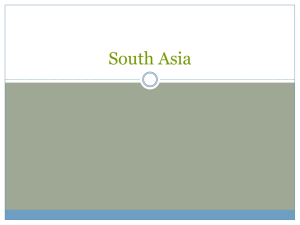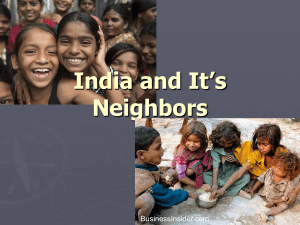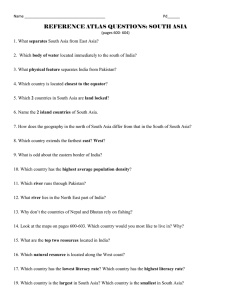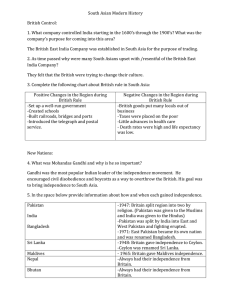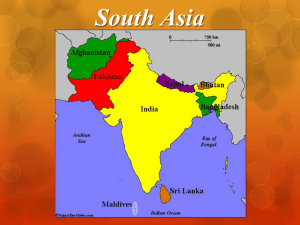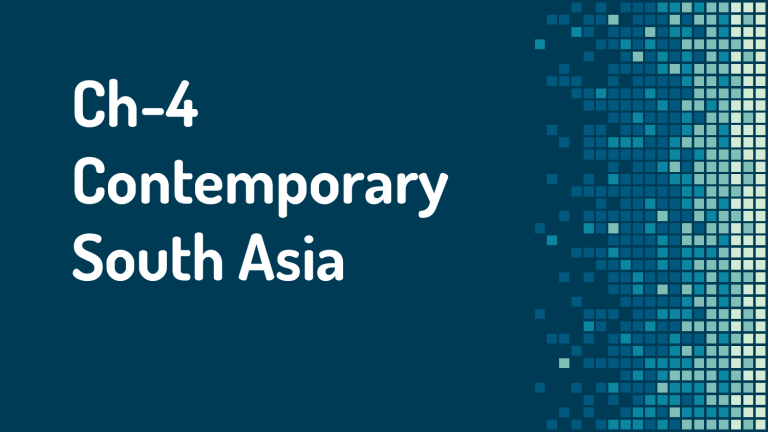
Ch-4 Contemporary South Asia MAP 2 What is South Asia? The expression ‘South Asia’ usually includes the following countries: Bangladesh, Bhutan, India, the Maldives, Nepal, Pakistan and Sri Lanka ● ● ● ● ● ● 3 South Asia stands for diversity in every sense and yet constitutes one geopolitical space The various countries in South Asia do not have the same kind of political systems Srilanka and India have successfully operated a democratic system since independence Pakistan and Bangladesh have experienced both civilian and military rulers Till 2006,Nepal was a constitutional monarchy Despite the mixed record of democratic experience,the people in all these countries share the aspiration for democracy SOME COMMON FEATURES OF SOUTH ASIA ● ● ● ● ● ● ● 4 ● The mighty Himalayas in the north ,the vast Indian Ocean the Arabian Sea and the Bay of Bengal in the south, west and east respectively provide a natural insularity to the region The South Asian subcontinent is distinct due to its linguistic, social and cultural composition Most countries of the region have had a colonial past which binds them together in their experience of struggle for freedom It is a region where rivalry and goodwill,hope and despair coexist All the countries in the region are developing nations and struggling towards economic progress Unemployment,poverty,illiteracy,overpopulation are some common problems faced by countries in this region Afghanistan and Myanmar are often included in discussions of the region as a whole China is an important player but is not considered to be a part of the region MILITARY AND DEMOCRACY IN PAKISTAN In Pakistan,military rule and democracy have played hide and seek since its independence Immediately after the implementation of Pakistan’s first Constitution,Gen.Ayub Khan got himself elected.But popular dissatisfaction against his rule gave way to military dictatorship under Gen.Yahya Khan ● After 1971 Indo Pak War an elected government was formed under the leadership of Zulfikar Ali Bhutto but after six years the Bhutto government was removed by Gen. Zia-ul-Haq in 1977 ● 1982 ,Gen.Zia faced a pro democracy movement and in 1988 a democratic government came to power under Benazir Bhutto ● 1991,Benazir was replaced by Nawaz Sharif as the prime minister ● 1999, army again stepped in and Nawaz Sharif was removed by a military coup staged by Gen.Pervez Musharraf ● 2005,Pervez Musharraf got himself elected as the President ● 2018 - Former international cricket star Imran Khan becomes prime minister through elections 6 Hence we can conclude that military rule and democracy are two sides of the same coin in Pakistan REASONS FOR FAILURE OF DEMOCRACY IN PAKISTAN The social dominance of the military and its active participation in politics has not let democracy thrive in Pakistan Involvement of Clergy and landowning aristocracy in politics has led to the frequent overthrow of elected governments and the establishment of military government Pakistan's conflict with India has made the pro-military groups more powerful.These groups feel that Pakistan’s security will be harmed by selfish minded political parties and thus they support the continuance of army’s interference in politics The lack of genuine international support for democratic rule in Pakistan has further encouraged the military to continue its dominance Fear of the threat 'Global Islamic Terrorism and the apprehension that Pakistan's nuclear arsenal might fall into the hands of these terrorist groups, the military regime in Pakistan has been supported by west The only ray of hope is that….. While democracy has not been fully successful in Pakistan, there has been a strong pro-democracy sentiment in the country. Pakistan has a courageous and relatively free press and a strong human rights movement. 7 DEMOCRACY IN BANGLADESH Bangladesh a part of Pakistan from 1947 to 1971 (East Pakistan) The people of this region resented the domination of western Pakistan and the imposition of the Urdu language Sheikh Mujib-ur-Rahman,a popular leader, led the struggle against domination of West Pakistan In 1970,his party,Awami League, launched a popular movement against West Pakistan. Gen.Yahya Khan, tried to brutally suppress the mass movement Thousands were killed by the Pakistan army. This led to a large scale migration into India, creating a huge refugee problem for India The government of India supported the demand of the people of East Pakistan for their independence and helped them financially and militarily This resulted in a war between India and Pakistan in December 1971 that ended in the surrender of the Pakistani forces in East Pakistan and the formation of Bangladesh as an independent country Bangladesh drafted its new constitution 9 However, in 1975 Sheikh Mujib got the constitution amended to shift from the parliamentary to presidential form of government. He also abolished all parties except his own, the Awami League This led to conflicts and tensions In a dramatic and tragic development, he was assassinated in a military uprising in August 1975 The new military ruler, Ziaur Rahman, formed his own Bangladesh National Party and won elections in 1979 He was assassinated and another military takeover followed under the leadership of Lt. Gen. H. M. Ershad The people of Bangladesh soon rose in support of the demand for democracy Mass public protests made Ershad step down in 1990 Elections were held in 1991. Since then representative democracy based on multi-party elections has been working in Bangladesh. 10 MONARCHY AND DEMOCRACY IN NEPAL NEPAL’S MARCH TOWARDS DEMOCRACY Nepal was a Hindu Kingdom in the past and then a constitutional monarchy in the modern period ● Common people wanted a more open and responsive system of government ● The King accepted the demand for a new democratic constitution in 1990 ● During 1990’S the MAOISTS of Nepal were successful in spreading their influence in many parts of Nepal ● For some times, there was a Triangular conflict among the Monarchists,The democrats and the Maoists ● In 2002, King abolished the parliament & dismissed the govt. ● In April 2006, there were massive, country wide, pro- democracy protests after which the king was forced to restore the House of Representatives 12 Nepal’s transition to democracy is not complete Some sections in Nepal still think that a nominal monarchy is necessary for Nepal to retain its link with the past ● The Maoist groups want the constitution to include the radical programmes of social and economic restructuring ● All the parties in the SPA may not agree with this programme ● The Maoists and some other political groups are also deeply suspicious of the Indian government and its role in the future of Nepal. 13 THE ETHNIC CONFLICT IN SRI LANKA IPKF AND LTTE THE PRINCIPAL PLAYERS IN THE ETHNIC CONFLICT WERE The Sinhala community- has the dominant population in Sri Lanka.They were hostile to the Tamils who had migrated from India in the past.The Sinhalas thought that tamils should not be given any special concessions in Sri Lanka Sri Lankan Tamils- were not happy with this and it led to rise of militancy under Liberation Tigers of Tamil Eelam (LTTE) India’s role-The problem involved Tamils of Indian origin,hence India got involved in a situation which in due course did not prove to be very successful Rajiv Gandhi Government-got directly involved in 1987,when both the countries signed an accord for the deployment of Indian Peace keeping Force (IPKF) to fight the LTTE IPKF suspended- its military operations and withdrew in 1989 without attaining its objectives In spite of the ongoing conflict, Sri Lanka has registered considerable economic growth and recorded high levels of human development and has maintained its democratic government 15 MALDIVES The Maldives was a Sultanate till 1968 ● After 1968 it was transformed into a republic with a presidential form of government ● In June 2005, the parliament of the Maldives voted unanimously to introduce a multi-party system ● The Maldivian Democratic Party (MDP) dominates the political affairs of the island ● Democracy strengthened in the Maldives after the 2005 elections when some opposition parties were legalised ● In November 1988, when some Tamil mercenaries from Sri Lanka attacked the Maldives, the Indian air force and navy helped to stop the invasion ● India has also contributed towards the island’s economic development, tourism and fisheries 17 BHUTAN Bhutan is still a monarchy but the king has initiated plans for its transition to multi-party democracy 19 INDIA’S RELATIONS WITH ITS NEIGHBOURS AREAS OF AGREEMENT AND DISAGREEMENT 20 INDIA AND BANGLADESH Areas of Agreement and Disagreement AGREEMENT Economic relations have improved considerably in the last ten years ● Bangladesh is a part of India’s Look East policy that wants to link up with Southeast Asia via Myanmar ● On disaster management and environmental issues, the two states have cooperated regularly ● Efforts are on to broaden the areas of cooperation further by identifying common threats and being more sensitive to each other’s needs. 22 Areas of Agreement and Disagreement DISAGREEMENT The governments of India and Bangladesh have had differences over several issues including the sharing of the Ganga and Brahmaputra river waters ● The Indian government has been unhappy with Bangladesh’s denial of illegal immigration to India ● India has criticized Bangladesh for its support of anti-Indian Islamic fundamentalist groups ● Also Bangladesh’s refusal to allow Indian troops to move through its territory to northeastern India, and its decision not to export natural gas to India or allow Myanmar to do so through Bangladeshi territory is an irritant ● Bangladeshi governments have felt that the Indian government behaves like a regional bully over the sharing of river waters, encouraging rebellion in the Chittagong Hill Tracts, trying to extract its natural gas and being unfair in trade ● 23 The two countries have not succeeded in resolving their boundary dispute. Areas of Agreement and Disagreement Areas Of Agreement Nepal and India enjoy a very special relationship that has very few parallels in the world ● A treaty between the two countries allows the citizens of the two countries to travel to and work in the other country without visas and passports ● Despite differences, trade, scientific cooperation, common natural resources, electricity generation and interlocking water management grids hold the two countries together ● There is a hope that the consolidation of democracy in Nepal will lead to improvements in the ties between the two countries. 25 Disagreement Despite this special relationship, the governments of the two countries have had trade- related disputes in the past ● The Indian government has often expressed displeasure at the warm relationship between Nepal and China ● Indian security agencies see the Maoist movement in Nepal as a growing security threat, given the rise of Naxalite groups in various Indian states from Bihar in the north to Andhra Pradesh in the south ● Many leaders and citizens in Nepal think that the Indian government interferes in its internal affairs, has designs on its river waters and hydro-electricity, and prevents Nepal, a landlocked country, from getting easier access to the sea through Indian territory INDIA AND SRI LANKA Areas of Agreement and Disagreement Areas Of Agreement India signed a free trade agreement with Sri Lanka, which strengthened relations between two countries ● India’s help in post-tsunami reconstruction in Sri Lanka has also brought the two countries closer 27 Disagreement The difficulties in the relationship between the governments of India and Sri Lanka are mostly over ethnic conflict in the island nation ● Indian leaders and citizens find it impossible to remain neutral when Tamils are politically unhappy and are being killed ● After the military intervention in 1987, the Indian government now prefers a policy of disengagement vis-à-vis Sri Lanka’s internal troubles. INDIA AND BHUTAN Areas of Cooperation India enjoys a very special relationship with Bhutan and does not have any major conflict with the Bhutanese government ● The efforts made by the Bhutanese monarch to weed out the guerrillas and militants from northeastern India have been helpful to India ● India is involved in big hydroelectric projects in Bhutan and remains the Himalayan kingdom’s biggest source of development aid. 29 INDIA AND MALDIVES Areas of Cooperation India’s ties with the Maldives remain warm and cordial ● In November 1988, when some Tamil mercenaries from Sri Lanka attacked the Maldives, the Indian air force and navy reacted quickly to the Maldives’ request to help stop the invasion ● India has also contributed towards the island’s economic development, tourism and fisheries. 31 INDIA AND PAKISTAN Areas of Conflict ● ● ● ● ● ● ● ● ● 33● 1947-Soon after the partition, the two countries got embroiled in a border conflict over the fate of Kashmir The 1965 War failed to settle the matter In 1971, India won a decisive war against Pakistan but the Kashmir issue remained unsettled There is conflict over strategic issues like the control of the Siachen glacier and over acquisition of arms In 1998, India conducted a nuclear explosion in Pokaran. Pakistan responded within a few days by carrying out nuclear tests in the Chagai Hills 1999-The kargil war yet another low point of relations between the two countries The Indian government has blamed the Pakistan government for helping the Kashmiri militants with arms, training, money and protection to carry out terrorist strikes against India The Indian government also believes that Pakistan’s spy agency, Inter Services Intelligence (ISI), is involved in various anti-India campaigns in India’s northeast, operating secretly through Bangladesh and Nepal Pakistan, in turn, blames the Indian government and its security agencies for fomenting trouble in the provinces of Sindh and Balochistan India and Pakistan also have had problems over the sharing of river waters Areas of Cooperation ● ● ● ● ● ● ● ● 33 Although India-Pakistan relations seem to be a story of endemic conflict and violence, there have been a series of efforts to manage tensions and build peace In 1960-with the help of the World Bank, India and Pakistan signed the Indus Waters Treaty which has survived to this day in spite of various military conflicts in which the two countries have been involved The two countries have agreed to undertake confidence building measures to reduce the risk of war Social activists and prominent personalities have collaborated to create an atmosphere of friendship among the people of both countries Leaders have met at summits to understand each other better and to find solutions to the major problems between the two neighbours A number of bus routes have been opened up between the two countries Trade between the two parts of Punjab has increased substantially in the last five years Visas have been given more easily Does India Act as a Regional Hegemon/Bully ?? It is incorrect to view that the Indian government tries to dominate and interfere in the domestic affairs of the smaller countries of the region. ● ● ● ● ● 33 India is at the centre of South Asia. It shares boundaries with almost all the countries of the region.It has some differences and problems with its neighbours. However, India’s policy is to solve them by peaceful means. India has always come forward in times of crisis to help its neighbours Eg. India’s help in post-tsunami reconstruction in Sri Lanka has also brought the two countries closer. In 2015,Nepal suffered a major earthquake which devastated the country.India immediately came forward and sent several relief teams to help the people with medicines,food etc. In November 1988, when some Tamil mercenaries from Sri Lanka attacked the Maldives, the Indian air force and navy reacted quickly to the Maldives’ request to help stop the invasion. Indian government believes that political stability is necessary for the development of the region. Role Of External Powers In Influencing Bilateral Relations in South Asia ● ● ● ● ● ● 33 No region exists in the vacuum. It is influenced by outside powers and events no matter how much it may try to insulate itself from non-regional powers: China and the United States remain key players in South Asian politics. Sino-Indian relations have improved significantly in the last ten years, but China’s strategic partnership with Pakistan remains a major irritant. The US enjoys good relations with both India and Pakistan since the end of the Cold War and increasingly works as a moderator in India-Pakistan relations. Economic reforms and liberal economic policies in both countries have greatly increased the depth of American participation in the region. The large South Asian diasporas in the US and the huge size of population and markets of the region also give America an added stake in the future of regional security and peace. THANKS! CH-4 Contemporary South Asia 37
